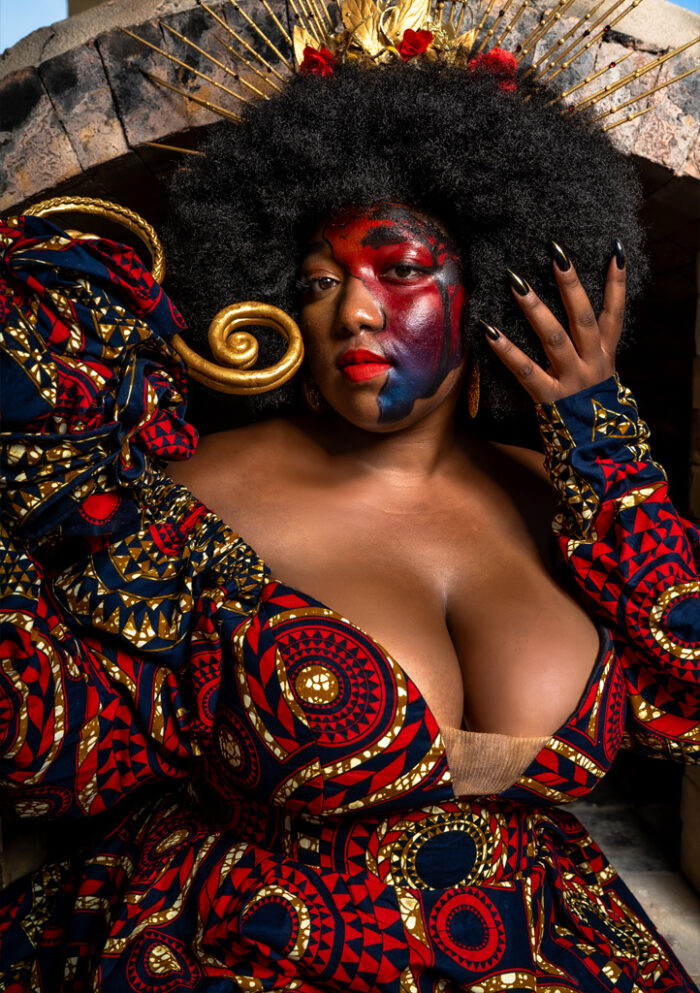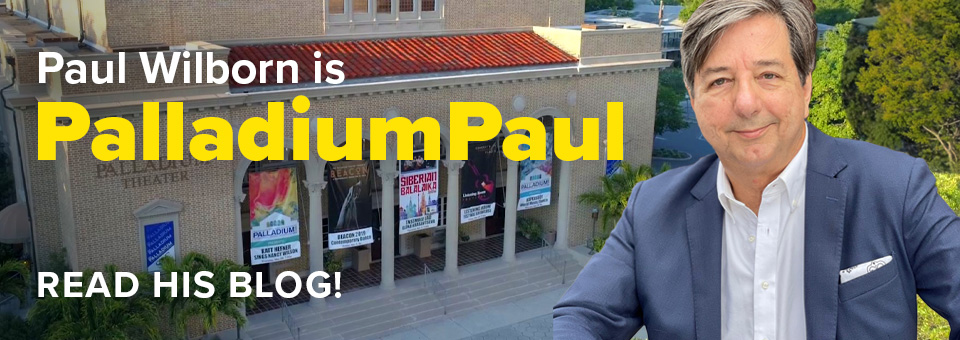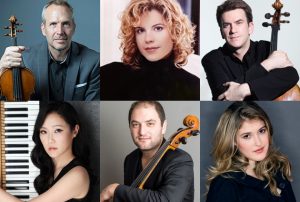Jeff Multer is back leading the Palladium Chamber Players this Wednesday in the fourth of our five-concert season.
The 7:30 p.m. concert features two piano quartets, one by Mozart and one by Gabriel Fauré, along with Ernő Dohnányi’s Serenade for Violin, Viola and Cello, Op. 10. Along with Multer on violin, the ensemble includes Jeewon Park , piano, Danielle Farina, viola, and Julian Schwarz, cello.
For tickets and more information you can follow this link, or call our box office at 727-822-3590. Our 2018-19 chamber series is supported by Westminster Communities of Florida and WEDU.
To get you prepared, I’ve included Kurt Loft’s program notes (which you’ll also find in our program).
I’ll see you at the concert, or at our post-show reception with the players. WEDU is again providing sweets from La Segunda bakery for the reception.
By Kurt Loft
Wolfgang Amadeus Mozart (1756-1791)
Piano Quartet No. 2 in E flat Major K. 493
In the opening scene of Milos Forman’s 1984 film, Amadeus, the composer Antonio Salieri tries to take his own life, screaming “Mozart!” in exasperation. As Salieri is rushed off to a hospital, Mozart’s Symphony No. 25 explodes off the screen and kicks off the story of one of the most loved musicians of all time. The movie isn’t straight biography so much as a crystallization of the glory of art against the tragedy of its provider, in this case, a wunderkind who left the world much too soon.
 Mozart’s genius is the stuff of legend, and needs little reinforcement more than two centuries after his death. In his 35 years, he gave us 626 published creations, and at least a hundred rank as supreme masterpieces in Western art. Within that group, a prized handful seem to have been forged by a higher power.
Mozart’s genius is the stuff of legend, and needs little reinforcement more than two centuries after his death. In his 35 years, he gave us 626 published creations, and at least a hundred rank as supreme masterpieces in Western art. Within that group, a prized handful seem to have been forged by a higher power.
“As an artist, as a musician, Mozart was not a man of this world,’’ writes Alfred Einstein in his classic biography, Mozart: His Character, His Work. “Mozart’s music, which to so many of his contemporaries seemed to have the brittleness of clay, has long since been transformed into gold, gleaming in the light, though it takes on a different luster for each new generation.’’
If Mozart’s operas contain his most intimate music, his best chamber works are equally as humane, including the Piano Quartet No. 2 ─ one of the earliest combinations for piano and string trio. But he didn’t treat it as a newcomer: The writing, especially for the keyboard in the opening movement, is pure and exacting, bright in color and fresh in invention. Mozart had earlier completed his operatic masterpiece, Marriage of Figaro, and listeners can feel its influence in the aria-like conversation among violin, viola and cello.
Mozart reserved one of his purest melodies for the larghetto, going back and forth between violin and piano, followed by a profusion of good tunes so masterfully synchronized in the closing rondo. Listening to this music with eyes closed, it almost sounds like a chamber-sized piano concerto.
Ernő Dohnányi (1877-1960)
Serenade for Violin, Viola and Cello, Op. 10 (1902-1903)
Dohnanyi was one of those fortunate musicians who struck gold early in life. His very first published composition won praise from Brahms, a seal of approval no amount of money could buy. He also was recognized as a gifted pianist, and his decision to specialize in Beethoven earned him consistent box office percentages and helped launch a comfortable career.

Jeewon Park
As his reputation grew, Dohnanyi received invitations to join music societies and universities around Europe, but he preferred to stay close to home and help develop, along with fellow composers Bartok and Kodaly, the musical voice of his native Hungary. He married a pianist, and in 1902 his wife gave birth to a son, Hans, who would later join the Nazi resistance during the war ─ and pay for it with his life.
Political unrest in 1948 forced Dohnanyi to leave Hungary for the United States, where he enjoyed acclaim as a concert pianist, particularly his touring performances of Beethoven’s Piano Concerto No. 4. A year later, he accepted a teaching position at Florida State University, where in 1960 he make his final appearance, conducting the same Beethoven concerto with a student soloist. Dohnanyi’s grave can be found at Roselawn Cemetery in Tallahassee.
Unlike other European composers of his time, Dohnanyi eschewed musical trends and contemporary movements. He embraced Romanticism, evident in three conservative symphonies, a pair of piano concertos, and much likeable chamber music. His last completed work, the American Rhapsody of 1953, made use of traditional American folk tunes.
One of his boldest strokes is the Serenade on tonight’s program. The opening movement is a tightly wound, two-minute march modeled after Beethoven’s Op. 8 Serenade, with the intent of “updating’’ the classical model. A sumptuous romanza follows, and its melody – repeated by each instrument – was greatly admired by the concert violinist Jascha Heifetz. After a foot-tapping scherzo, the music settles into an elegiac set of five variations, the longest and most elaborate part of the work. The closing rondo takes off at lightning speed and never looks back, ending the work in a whirl of nervous energy.
Gabriel Fauré (1845-1924)
Piano Quartet No. 1 in C Minor, Op. 15
Faure was destined to become a quiet and reserved composer of church music, steeped on the glories of the Renaissance. His boyhood school, the Ecole Niedermeyer, taught music students to serve God, not concert audiences, so personal expression was a sacred affair. Then one day, the young Faure took a class taught by Camille Saint-Saens, who did the unthinkable: He exposed his student to the progressive works of Liszt and Wagner, agents of the “music of the future.’’ This hit hard, and Faure, along with four other Frenchmen, founded the National Progressive Society of Music.
Faure never achieved the status of his contemporary, Claude Debussy, who called him “the master of charms.’’ But they share similar gifts, and a distinct, refined musical voice. Faure expressed himself in subtle shades and colors, and clothed his ideas within the classical precepts of order and restraint. If any composer can be thought of as polite, it was Faure. But this is not to imply that his music won’t move the listener; to the contrary, its passion is what makes it so appealing.
The sensuous language of the Piano Quartet in C Minor is among of his strongest creations. Faure completed it following an ill-fated love affair with the daughter of a prominent family. He received no commission for the work, and no doubt wrote it under emotional stress.
The tender melodies of the opening movement seem to come directly from his troubled heart, and the remarkable synthesis between piano and strings are a delight to hear unfold. The A delicate scherzo follows (note how he places the scherzo second, as opposed to its traditional role in the third movement), with plucked strings fluttering around a spacious piano melody and an abrupt tempo change.
The rising scales in the mournful adagio feel like a person breathing, and the section ends as quietly as it began. The finale harks back to the opening movement, adding unity to the whole, and borrows the rise and fall of the preceding section. The viola plays a lament soon taken up by the violin and cello, followed by a few moments of reflection, then the pulse quickens as the group wraps things up with an animated coda.








Leave a Reply